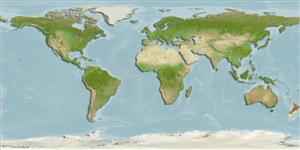Classification / Names
Common names | Synonyms | Catalog of Fishes (gen., sp.) | ITIS | CoL | WoRMS | Cloffa
Actinopterygii (ray-finned fishes) >
Aulopiformes (Grinners) >
Aulopidae (Aulopus)
Etymology: Leptaulopus: Name from Greek 'leptos' meaning slender and 'aulopus' for a name long applied to the broader group of fi�shes to which the genusbelong; referring to the slender form of the speciesit comprises.; erythrozonatus: Name from Greek 'erythros' for ‘red’ and 'zone' for ‘belt’, referring to the distinctive red bands on the dorsal and caudal fins.
Environment / Climate / Range
Ecology
Marine; demersal; depth range 130 - 280 m (Ref. 94775). Subtropical, preferred ?
Southwestern Pacific: apparently confined to the Australasian region with a trans-Tasman distribution; recorded from New Zealand (Bay of Plenty), northern New South Wales (NE coast of North I. and off Batemans Bay), and yet to be confirmed from Norfolk Ridge.
Size / Weight / Age
Maturity: Lm ? range ? - ? cm
Max length : 27.4 cm SL male/unsexed; (Ref. 94775)
Short description
Morphology | Morphometrics
Dorsal
soft rays
(total): 15-16;
Anal
soft rays: 10 - 11;
Vertebrae: 44. This species is distinguished by the following characters: D 15-16; A 10-11; vertebrae 26 or 27 + 17 or 18 = 44; lateral line scales 44 + 1, below lateral line 4.5; predorsal scales 20; gill rakers 3 + 12; elongated snout, length 11.5-12.4% SL and 34.6-36.5% HL, which is much longer than eye diameter, dorsoventrally flattened, narrowly rounded from above; narrow bony interorbital, width 3.0-3.5% SL and 8.9-10.3% HL; snout tip to dorsal fin origin 42.5-43.7% SL in distance and 128-129% HL; anal �n base 92-9.8% SL and 27.0-29.1% HL; colour of posterior end of maxilla and posterior and ventral margins of preopercle stark white; translucent dorsal fin with 4-6 narrow submarginal stripes from base to outer edge of fin, stripes posteriorly angled obliquely, intervening spaces of fin rays white; caudal fin white with 4-5 red bands crossing each lobe and proximal bands continuous
across fin in some (Ref. 94775).
Life cycle and mating behavior
Maturity | Reproduction | Spawning | Eggs | Fecundity | Larvae
Gomon, M.F., C.D. Struthers and A.L. Stewart, 2013. A new genus and two new species of the family Aulopidae (Aulopiformes), commonly referred to as Aulopus Flagfins, Sergeant Bakers or Threadsails, in Australasian waters. Spec. Div. 18:141-161. (Ref. 94775)
IUCN Red List Status (Ref. 115185)
CITES (Ref. 94142)
Not Evaluated
Threat to humans
Harmless
Human uses
More information
Common namesSynonymsMetabolismPredatorsEcotoxicologyReproductionMaturitySpawningFecundityEggsEgg development
Age/SizeGrowthLength-weightLength-lengthLength-frequenciesMorphometricsMorphologyLarvaeLarval dynamicsRecruitmentAbundance
ReferencesAquacultureAquaculture profileStrainsGeneticsAllele frequenciesHeritabilityDiseasesProcessingMass conversion
Tools
Special reports
Download XML
Internet sources
Estimates of some properties based on models
Phylogenetic diversity index (Ref.
82805): PD
50 = 0.7502 [Uniqueness, from 0.5 = low to 2.0 = high].
Bayesian length-weight: a=0.00437 (0.00175 - 0.01091), b=3.13 (2.91 - 3.35), in cm Total Length, based on LWR estimates for this (Sub)family-body shape (Ref.
93245).
Trophic Level (Ref.
69278): 4.0 ±0.7 se; Based on size and trophs of closest relatives
Resilience (Ref.
69278): .
Vulnerability (Ref.
59153): Low vulnerability (23 of 100) .
